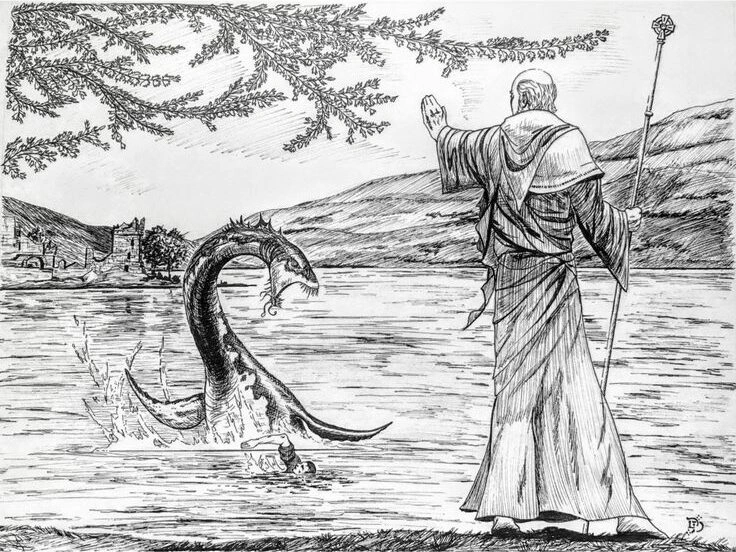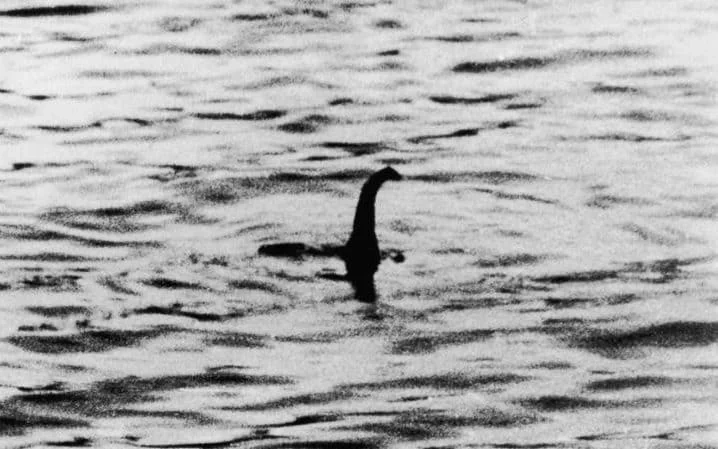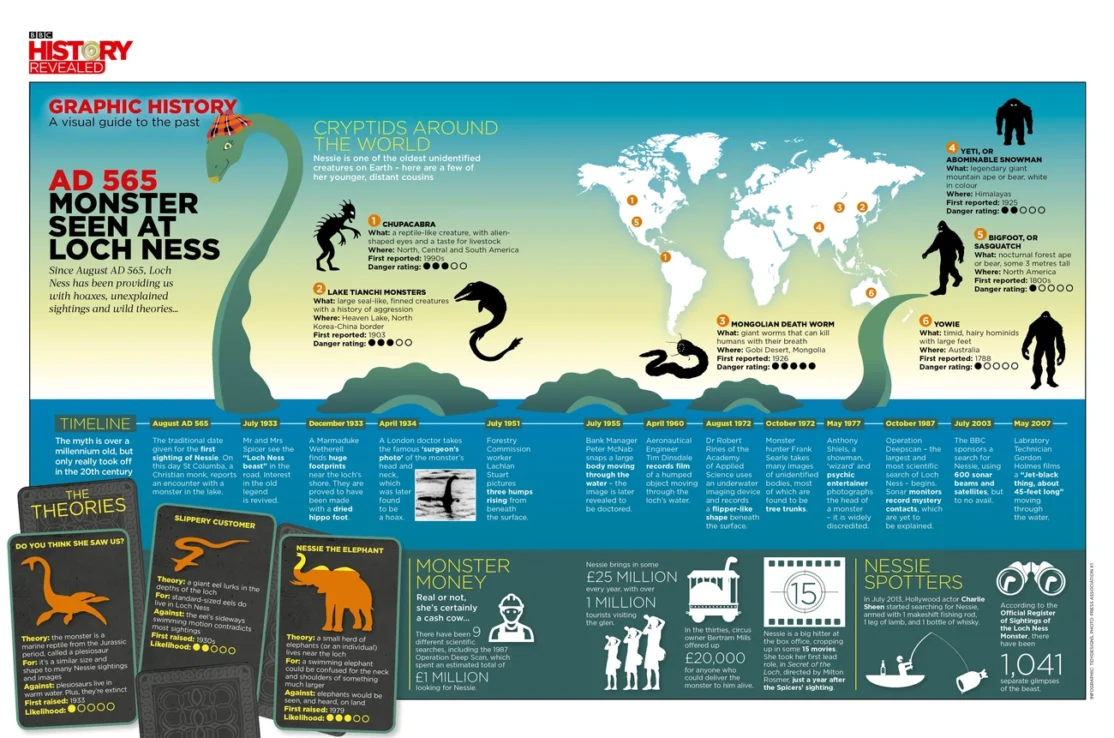The Loch Ness Monster has captivated imaginations worldwide since 1933. Scotland’s famous loch holds a mysterious beast that people have reported seeing over 1,155 times. The Official Loch Ness Monster Sightings Register shows even more activity, with 1,161 documented reports since 1996.
Nessie, as the creature is affectionately known, remains a beloved myth without conclusive proof. The legend brings nearly $80 million each year to Scotland’s economy. Scientists and enthusiasts have tried to find the truth behind the famous “surgeon’s photograph” that deceived the world for 60 years. A 2018 DNA survey found many eels but no signs of a plesiosaur in the loch’s waters. The mystery continues in this massive body of water that holds more freshwater than all of England and Wales’s lakes combined.
The Origins of the Loch Ness Monster Legend

Image Source: Scotland’s Stories
The Loch Ness Monster legend has deeper roots in Scotland’s ancient past than most people might think.
Ancient folklore and the story of Saint Columba
Stone carvings by the Picts from over 1,500 years ago show strange water creatures. These ancient Highland inhabitants seemed to know something unusual lived in their waters. Their carvings depicted a beast with an elongated muzzle and flippers instead of feet.
Saint Columba’s biography from the 7th century provides the first written record of the creature, describing an event from 565 AD. The saint came upon locals near River Ness who were burying a man killed by a water beast during his mission to convert the Picts. The creature approached threateningly as another man swam across the water. Columba raised his hand, made the sign of the cross and commanded, “Go no further. Do not touch the man. Go back at once”. The monster retreated “as if pulled back with ropes”.
Records show 21 more sightings between 1500 and 1800.
The rise of Nessie in 1933
A new shoreline road in 1933 gave people clear views of the loch, which sparked fresh interest in the Loch Ness Monster. Hotel manager Aldie Mackay and her husband spotted what she called a “whale-like creature” rolling in the water on April 15. The Inverness Courier published their story on May 2, 1933, which captured people’s imagination.
George Spicer and his wife’s sighting of a “large creature with a long, wavy, narrow neck” crossing the road brought even more attention to the mystery. Hugh Gray took the first claimed photo of the monster on November 12, 1933. Experts later suggested the photo showed an otter rolling in the water.
How the name ‘Loch Ness Monster’ became popular
The Inverness Courier’s editor Evan Barron first called the creature a “monster”. Reader letters poured in with their own encounter stories after the paper published the Spicers’ sighting on August 4, 1933.
London newspapers sent reporters to Scotland, and a circus offered £20,000 to anyone who could catch the beast. The name “Loch Ness Monster” stuck in the media. People started calling it “Nessie” in the 1940s, adding charm to the mysterious creature’s legend.
Famous Sightings and Photographic Evidence

Image Source: Don’t Take Pictures
People have debated for years whether is the Loch Ness Monster real or just a case of mistaken identity and clever hoaxes, based on various photographs and films.
The 1934 ‘Surgeon’s Photograph’
The most famous piece of Loch Ness Monster evidence came from London gynecologist Robert Kenneth Wilson in 1934. His photo showed what looked like a slender neck coming out of the water and became the classic image of Nessie for decades. The Daily Mail bought exclusive rights to publish the image, and people believed it was real proof for almost 60 years.
The truth came out in 1994. Marmaduke Wetherell created this clever hoax to get back at the Daily Mail after they made fun of his fake Nessie footprints claim. His son-in-law Christian Spurling built a model using a toy submarine and shaped a head and neck from wood putty.
The Dinsdale film and sonar readings
Aeronautical engineer Tim Dinsdale shot footage in April 1960 of what he called a “mahogany red” hump moving across Loch Ness. The Joint Air Reconnaissance Intelligence Center studied the film in 1966 and said the object was “probably animate”. Modern analysis shows the footage likely captured a fishing boat in poor light.
The mystery grew deeper with sonar readings. The fishing boat Rival III picked up a large object 146 meters down that tracked their vessel for 800 meters in December 1954.
Modern sightings and drone footage
Drone technology has given us new ways to look at the loch. Outdoorsman Richard Mavor’s drone caught what seemed to be a long-necked creature swimming near the shore in August 2021. Experts quickly called it a likely hoax that probably used a toy plesiosaur.
The Official Loch Ness Monster Sightings Register keeps track of all reports, with 1,162 recorded sightings as of May 2025. Someone spotted “something long and thin” in Urquhart Bay on May 23, 2025, marking the latest confirmed sighting.
The role of media in spreading Nessie stories
The media’s influence increased Loch Ness Monster theories significantly. The story took off after the Inverness Courier published the Spicer sighting in August 1933. London newspapers sent their reporters to Scotland, and the coverage turned a local mystery into worldwide news.
Scientific Investigations and New Evidence

Image Source: BBC Science Focus Magazine
“The strongest evidence that Nessie is in fact down there comes from the unexplained sonar contacts made over the years. They have been remarkably consistent in both their appearance and make up since sonar was first introduced to the loch.” — Loch Ness Sightings Study (site authorship), Loch Ness Sightings Official Archive
Scientists now use advanced technology to answer the question: is the Loch Ness Monster real. Their major investigations have revealed surprising results.
Operation Deepscan and sonar studies
October 1987 saw the biggest scientific search of Loch Ness. Operation Deepscan sent out 24 boats with Laurence X-16 sonar units that could spot objects as small as 1 foot. The team found three mysterious underwater targets between 78 meters (256ft) and 180 meters (590ft) deep. The strongest signal lasted 140 seconds. Sonar expert Darrell Laurence said these signals came from something “larger than a shark but smaller than a whale”. The BBC ran its own search in 2003 with 600 sonar beams but found nothing unusual.
The 2018 DNA survey and its findings
Professor Neil Gemmell’s team launched a groundbreaking DNA study in 2018. They collected over 250 water samples from Loch Ness and identified about 3,000 different species. The samples revealed eel DNA almost everywhere, which sparked theories about giant eels. “There is absolutely no evidence of any reptilian sequences,” Gemmell stated, which ruled out the plesiosaur theory. The study found no proof of reptilian creatures but left room for the giant eel theory.
2023 high-tech search and thermal imaging results
The largest Loch Ness survey in 50 years took place in August 2023. Researchers used thermal-imaging drones, infrared cameras, and hydrophones to detect heat signatures and underwater sounds. Heavy clouds limited the drones’ effectiveness. The hydrophone picked up “four distinctive ‘gloops'”. Dragonfly Films’ thermal equipment spotted “an unusual heat signature” that looked like “a large mass near the shore”.
What scientists say about the new evidence
Most scientists remain doubtful about recent findings. Deepscan’s sonar system detected “a sizeable reading” in October 2023, which researchers called possible “substantial underwater presences”. Many experts believe these unusual signals come from known phenomena rather than mystery creatures. Gemmell points out that “a lack of evidence is not necessarily evidence of absence”. The scientific community tends to favor simple explanations – known animals, objects, or thermal layers creating false sonar readings.
Explaining the Mystery: Theories and Hoaxes

Image Source: BBC History Magazine
“They may be categorized as misidentifications of known animals, misidentifications of inanimate objects or effects, reinterpretations of Scottish folklore, hoaxes, and exotic species of large animals.” — Ronald Binns, Author, ‘The Loch Ness Mystery Solved’; former member, Loch Ness Phenomena Investigation Bureau
Scientists have found natural explanations for the frequent Nessie the Loch Ness Monster sightings that have puzzled people for decades.
Misidentified animals like eels and seals
The 2018 environmental DNA study found extraordinary amounts of eel DNA in Loch Ness. Professor Gemmell thinks giant eels might explain some sightings. “It is possible there are very large eels,” he said. A later study showed you have a 1 in 50,000 chance of seeing even a 1-meter-long eel. The odds of spotting larger ones are “virtually zero”. People often mistake otters, seals, and swimming deer for the monster.
Inanimate objects: logs, waves, and optical illusions
Many Loch Ness Monster theories start with everyday objects that fool our eyes. A partially submerged log can look just like Nessie’s famous hump. Boat wakes create snake-like patterns in the water. The loch’s weather conditions create mirages where light and air deceive viewers. Dr. Roy Chapman Andrews, a zoologist, pointed out in 1934 that “even the simplest optical illusions become convincing if told and retold”.
Famous hoaxes and debunked photos
The 1934 “Surgeon’s Photograph” stands as the most famous hoax. People discovered in 1994 that someone used a toy submarine with a head made from plastic wood. George Edwards admitted in 2013 that his 2011 photo used a fiberglass model from a National Geographic documentary. Every well-known Nessie photo has turned out to be either a planned trick or mistaken identity.
Why people still ask: does the Loch Ness Monster exist?
Monster stories satisfy deep human needs, according to psychologists. Dr. June Singer believes monster fantasies “lift us out of the known and give us the courage and imagination to create something new”. Dr. Bruno Bettelheim observed that “unnamed anxieties are much more threatening than something to which we can attach a name and form”. The question is the Loch Ness Monster real lives on because it meets psychological needs beyond just proof.
Conclusion
The Loch Ness Monster has fascinated people through the ages, though no one has ever proved it exists. Scientists have looked at more than a thousand reported sightings and conducted many studies. Their findings suggest people either misidentified what they saw or fell for clever hoaxes rather than spotting an actual prehistoric creature in the loch. All the same, Nessie’s charm remains strong.
Scientists have ruled out any chance of finding a plesiosaur or other large reptile in the loch. Giant eels, floating logs, or optical illusions seem to explain the mystery better. The legend stays alive because people need a sense of wonder and mystery in their lives, whatever science tells them.
Your belief in Nessie doesn’t matter as much as how this legend affects the world around it. Scotland’s tourism industry pulls in nearly $80 million each year, showing how myths can change entire regions. Nessie’s real value might not lie in proving it exists but in getting people excited about nature’s mysteries.
We might never know if the Loch Ness Monster is real. Better detection methods and technology keep emerging, and researchers won’t stop looking. Nessie swims on in our shared imagination, teaching us that some mysteries deserve to live on—even if science suggests they shouldn’t.
Key Takeaways
Despite over 1,100 documented sightings since 1933, scientific evidence reveals the truth behind one of the world’s most enduring mysteries.
• The famous 1934 “Surgeon’s Photograph” was exposed as an elaborate hoax using a toy submarine, fooling the world for 60 years.
• The 2018 DNA survey found no reptilian evidence but massive amounts of eel DNA, suggesting giant eels could explain some sightings.
• Most Nessie sightings result from misidentified animals (otters, seals), floating logs, boat wakes, and optical illusions created by atmospheric conditions.
• Scientists have ruled out plesiosaurs or large reptiles, with modern investigations using sonar, thermal imaging, and DNA analysis finding no conclusive proof.
• The legend generates nearly $80 million annually for Scotland’s economy, proving that some mysteries are more valuable as myths than facts.
While the scientific consensus leans toward natural explanations, the Loch Ness Monster continues to serve our psychological need for wonder and the unexplained, ensuring Nessie’s place in our collective imagination regardless of evidence.
FAQs
Q1. Is there any scientific evidence supporting the existence of the Loch Ness Monster? While there have been numerous reported sightings, scientific investigations have not found conclusive evidence of a large unknown creature in Loch Ness. The 2018 DNA survey found no reptilian DNA but did detect high amounts of eel DNA, leading to speculation about giant eels.
Q2. What was the most famous photograph of the Loch Ness Monster? The most iconic image was the 1934 “Surgeon’s Photograph,” which showed what appeared to be a long neck emerging from the water. However, it was revealed to be an elaborate hoax in 1994, involving a toy submarine with a sculpted head and neck.
Q3. How many reported sightings of the Loch Ness Monster have there been? The Official Loch Ness Monster Sightings Register has documented over 1,160 reported sightings since its establishment in 1996. The total number of reported sightings throughout history is even higher.
Q4. What natural explanations have been proposed for Loch Ness Monster sightings? Scientists suggest that many sightings can be attributed to misidentified animals like otters, seals, or eels. Other explanations include inanimate objects such as floating logs, boat wakes, and optical illusions caused by the loch’s unique atmospheric conditions.
Q5. How has the Loch Ness Monster legend impacted Scotland’s economy? The Loch Ness Monster has become a significant tourist attraction, contributing nearly $80 million annually to Scotland’s economy. This demonstrates how a popular myth can have substantial real-world economic effects, regardless of its scientific validity.
 01463 223243
01463 223243
 Find
Find Book
Book


